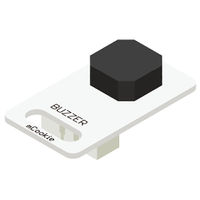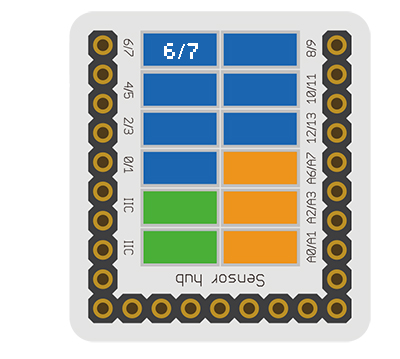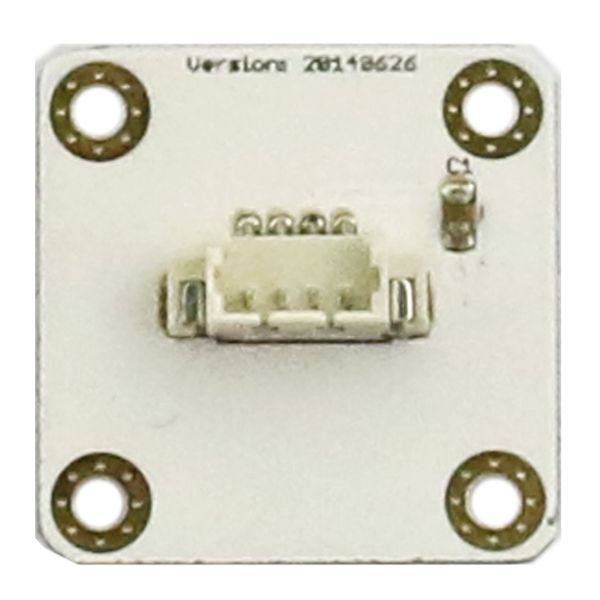Difference between revisions of "Sensor-Buzzer"
(→Introduction of Pins) |
|||
| Line 1: | Line 1: | ||
{{Language|Microduino-Buzzer}} | {{Language|Microduino-Buzzer}} | ||
| − | {| style="width: | + | {| style="width: 80%;" |
|- | |- | ||
| | | | ||
| Line 40: | Line 40: | ||
*Schematic diagram: '''[[File: Sensor-Buzzer.Zip]]''' | *Schematic diagram: '''[[File: Sensor-Buzzer.Zip]]''' | ||
| − | == | + | ==Usage== |
| + | |||
| + | ===Basic Functionality=== | ||
| + | The LED Trinket is a simple trinket which emits light when passed with a sufficient voltage. A Core module can supply voltage to the LED Trinket. | ||
| + | {| class="wikitable" | ||
| + | |+Crash Sensor State Table | ||
| + | |- | ||
| + | ! Pin State | ||
| + | ! LED State | ||
| + | |- | ||
| + | |HIGH | ||
| + | |Emits Light | ||
| + | |- | ||
| + | |LOW | ||
| + | |No Light | ||
| + | |} | ||
| + | |||
| + | ===Programming=== | ||
| + | <tab name="Arduino for Microduino" style="width:100%;"> | ||
| + | ==Introduction== | ||
| + | The LED Trinket is used as a simple output pin. Therefore, the '''pinMode''' and '''digitalWrite''' functions will be used. | ||
| + | ==Key Functions== | ||
| + | *Required Libraries: None | ||
| + | *Key Functions: | ||
| + | ** '''pinMode(pin_number, pin_mode)''' - sets the mode for the pin | ||
| + | ***'''pin_number''' - is the pin number that the trinket is connected to | ||
| + | ***'''pin_mode''' - is the mode to set the pin to. Either '''INPUT''' or '''OUTPUT''' | ||
| + | ** '''digitalWrite(pin_number)''' - Changes the state of the pin either to HIGH or LOW | ||
| + | ***'''pin_number''' - is the pin number that the trinket is connected to | ||
| + | |||
| + | ==Example== | ||
| + | This is a simple example which turns on and off the LED at 1 second intervals. | ||
| + | |||
| + | '''Note''': Important lines of code are highlighted. | ||
| + | |||
| + | <syntaxhighlight lang="cpp" highlight="1,2,10,11,17,18,23,24"> | ||
| + | //Define the pin the sensor is connected to | ||
| + | const int LED_PIN = 6; | ||
| + | |||
| + | void setup() { | ||
| + | // put your setup code here, to run once: | ||
| + | |||
| + | //Initial serial communication port at 9600 baud | ||
| + | Serial.begin(9600); | ||
| + | |||
| + | //Configure the pin into output mode | ||
| + | pinMode(LED_PIN, OUTPUT); | ||
| + | } | ||
| + | |||
| + | void loop() { | ||
| + | // put your main code here, to run repeatedly: | ||
| + | |||
| + | //Perform a digitalWrite with HIGH to turn on the LED | ||
| + | digitalWrite(LED_PIN, HIGH); | ||
| + | |||
| + | //Delay 1 second | ||
| + | delay(1000); | ||
| + | |||
| + | //Perform a digitalWrite with LOW to turn off the LED | ||
| + | digitalWrite(LED_PIN, LOW); | ||
| + | |||
| + | //Delay 1 second | ||
| + | delay(1000); | ||
| + | } | ||
| + | </syntaxhighlight> | ||
| + | Copy and paste the code above to the Arduino IDE or | ||
| + | |||
| + | Download the above example: n/a | ||
| + | </tab> | ||
===Program Download=== | ===Program Download=== | ||
*Download and unzip the program '''[[File:Sensor-Buzzer_Test.zip]]''' | *Download and unzip the program '''[[File:Sensor-Buzzer_Test.zip]]''' | ||
Revision as of 19:34, 18 August 2017
| Language: | English • 中文 |
|---|
|
The product number of Sensor-Buzzer is: MSDO11 Sensor-Buzzer is a passive buzzer. Like a magnetic speaker, it needs voltage with different frequency so that it can make sound accordingly. The pitch becomes louder when the frequency gets higher. ContentsIntroduction of Pins
Features
Specification
Document
UsageBasic FunctionalityThe LED Trinket is a simple trinket which emits light when passed with a sufficient voltage. A Core module can supply voltage to the LED Trinket.
ProgrammingIntroductionThe LED Trinket is used as a simple output pin. Therefore, the pinMode and digitalWrite functions will be used. Key Functions
ExampleThis is a simple example which turns on and off the LED at 1 second intervals. Note: Important lines of code are highlighted. //Define the pin the sensor is connected to
const int LED_PIN = 6;
void setup() {
// put your setup code here, to run once:
//Initial serial communication port at 9600 baud
Serial.begin(9600);
//Configure the pin into output mode
pinMode(LED_PIN, OUTPUT);
}
void loop() {
// put your main code here, to run repeatedly:
//Perform a digitalWrite with HIGH to turn on the LED
digitalWrite(LED_PIN, HIGH);
//Delay 1 second
delay(1000);
//Perform a digitalWrite with LOW to turn off the LED
digitalWrite(LED_PIN, LOW);
//Delay 1 second
delay(1000);
}Copy and paste the code above to the Arduino IDE or Download the above example: n/a Program Download
Programming
Hardware Setup
Result
ApplicationThe buzzer can produce many weird sound. Maybe you can add some keys to it to compose a piece of wonderful music. ProjectsPurchaseHistoryGallery
|
Purchase
History
Image
- Front
- Back




